Can You Really Build an Online Business from Nothing?
Have you ever wondered what it takes to start an online business when you’re working with… basically nada? No big savings account, no investor calling you, and no prior experience in business. Just a laptop, Wi-Fi, plus a mix of ambition and maybe too much coffee.
The short answer: it’s absolutely possible.
In fact, millions of people are doing it right now. Online retail is booming—global e-commerce sales are projected to surpass $6.4 trillion in 2025, representing nearly 24% of global retail activity. Meanwhile, the freelance economy has exploded, with 1.57 billion freelancers worldwide (about 47% of the workforce!). Digital tools, payment platforms, and accessible no-code website builders mean that starting from your living room is normal—not a fairy tale.
Some online ventures scale into six-figure enterprises with teams; others stay lean lifestyle businesses that give people the freedom to escape the 9-to-5 grind.
But here’s the catch: there’s a lot of conflicting advice out there. Between “gurus” selling get-rich-quick playbooks and vague tutorials, it’s easy to feel lost.
That’s why this guide is different: it combines evergreen, tried‑and‑true steps with the freshest real‑world data and practical examples. By the end, you’ll know exactly:
- How to validate a business idea before spending money.
- Which tools and platforms cut through the noise.
- How to set up your site and brand presence even as an absolute beginner.
- What marketing strategies actually work in 2024–2025.
- Common pitfalls to avoid (because they can drain time and cash).
So grab your digital backpack—because we’re trekking step by step up the mountain called starting an online business from scratch.
Step 1: What’s the First Thing You Need to Do to Start an Online Business?
The first step isn’t building a fancy logo or setting up TikTok ads—it’s identifying and validating your business idea. If you’re not solving a real need, your business will be like pouring water into a leaky bucket.
Evergreen Idea Categories That Work Online
- Digital Products: online courses, eBooks, templates, stock photos, or printables.
- Freelance/Services: writing, design, coding, virtual assistance, coaching.
- E-commerce: dropshipping, print-on-demand, or your own handmade goods.
- Content-Based Businesses: blogs, YouTube, social accounts monetized via affiliate links, ads, and sponsorships.
Quick, Data-Driven Ways to Validate Your Idea
- Keyword Research: Are people actually Googling what you hope to sell? Tools like Ahrefs and Google Keyword Planner reveal monthly searches.
- Marketplaces Check: If thousands of Etsy / Amazon searches already exist in your niche, that signals demand.
- Ask Real Humans: Use TikTok polls, Reddit communities, or niche Facebook groups.
- Mini-Test: Launch a simplified version first (beta course, small digital product, pilot coaching offer).
Pro tip: Fall in love with solving problems, not with your product vision.
Step 2: How Do You Choose the Right Business Model?
Each online business is built around a model of making money. Which you choose depends on your skills, bandwidth, and goals.
Comparison of Models
| Model | Best For | Pros | Cons |
|---|---|---|---|
| Freelancing / Services | Skill-based professionals | Fast to earn, minimal startup costs | Time-for-money trap, income instability |
| Digital Products | Creators, educators | High margins, scalable, “passive” long term | Requires upfront effort; marketing heavy |
| E-commerce (Physical) | Product-oriented founders | Global reach, tangible appeal | Inventory/logistics customer support |
| Content & Affiliate | Writers, influencers | Flexible, low overhead, residual income | Slow ramp-up; algorithm dependence |
Stat to remember: The average freelancer earns ~$39/hour on platforms like Upwork, and demand for remote freelancers is growing faster than traditional hiring.
Step 3: How Do You Create a Business Plan Without Overcomplicating It?
No, you don’t need a 40-page investor deck to get moving. But you do need clarity.
Your lean, functional plan should cover:
- Target audience: Who precisely are you serving?
- Your offer: What problem are you solving, and how?
- Revenue model: One-off sales? Subscriptions? Services? A blend?
- Marketing approach: Where will customers discover you? (SEO? social? ads?)
- Budget & tools: What’s essential today? (Hint: usually <$200.)
Keep it to a one-pager in Google Docs or Notion—done is better than “someday perfect.”
Step 4: How Do You Set Up Your Online Business Legally?
This is the “adulting” part of building your business—boring? Maybe. Necessary? Absolutely.
- Register your business entity (LLC, sole prop, or equivalent).
- Secure your business name & domain together.
- Apply for tax ID / VAT / GST where needed.
- Business banking: never mingle personal & business finances.
- Contracts: If you provide services, sites like PandaDoc or RocketLawyer are lifesavers.
Step 5: How Do You Build a Professional-Looking Website?
You don’t need to code for 80 hours or hire a $10k developer. Tools today make it possible in 1 weekend.
Steps to launch:
- Get a domain (short, memorable, maybe niche-keyworded).
- Choose reliable hosting (Bluehost, SiteGround, or Shopify’s managed servers).
- Install WordPress (flexibility), or go with Shopify / Squarespace if you want drag‑and‑drop ease.
- Select a clean template/theme.
- Add crucial pages: About, Contact, Shop/Services, Privacy Policy, Terms.
- Optimize basics: mobile responsiveness, SEO metadata, caching for speed.
Treat your website like your storefront window—even if you’re huge on Instagram, people Google before buying.
Step 6: How Do You Attract Customers If Nobody Knows You Yet?
Your shiny website is useless without people visiting it. Marketing is where your business finds its lungs.
Beginner-Friendly Marketing Channels
- SEO: Write long-term, problem-solving blog posts.
- Social Media: Pick your lane: TikTok, Instagram, or LinkedIn. Don’t do all of them.
- Email Lists: ConvertKit/Mailchimp—start capturing emails from day one.
- Partnerships: Collaborate with micro-influencers or businesses with shared audiences.
- Paid Ads: Use carefully after validating your offer.
Real-Time Data That Proves the Potential
- Global e-commerce: expected to hit $6.419T in 2025.
- TikTok Shop US: GMV hit ~$9B in 2024, with 500,000+ active U.S. merchants.
- Freelance economy: ~1.57B freelancers globally, nearly half of the entire workforce.
- Email ROI: still one of the best—$36 return per $1 spent.
Pick ONE channel for your first growth push. Master it before multiplying.
Step 7: How Do You Scale an Online Business?
Once you’ve validated and made initial sales, it’s time to increase leverage.
Smart Scaling Tips:
- Automate recurring tasks with Zapier, Dubsado, client schedulers.
- Diversify income: add courses, memberships, additional services.
- Outsource: free your plate from admin tasks by hiring VAs.
- Boost retention: cheaper to keep clients than chase new ones.
- Expand reach: try paid campaigns, larger audiences.
FAQs About Starting an Online Business from Scratch
1. How much money do I need to start?
As little as $100 for a lean setup, but $200–$500 gives breathing room (domain, hosting, email tool, initial marketing).
2. Can I start without skills?
Yes, but you’ll be on a steep but rewarding learning curve. Start simple—free tools, low-cost online courses.
3. How fast will I make money?
Freelancing: weeks.
Digital products/e-commerce: months.
Affiliate/content blogs: usually 6–12 months.
4. Do I need to quit my job first?
Not at all. Many founders keep their 9–5 until revenue is steady.
5. What tools are absolutely essential?
A website, a professional email address, payment processor, and one marketing channel (SEO tool, email platform, or scheduler).
Final Thoughts: Your Turn to Start from Zero
Starting an online business can feel like staring up at a giant mountain. But remember—every giant player you know today once started with nothing more than an idea scribbled in a notebook.
You don’t need every shiny tool, every skill, or a perfect roadmap to succeed. You need one validated idea, a lean plan, a simple website, and the courage to put offers in front of real humans.
Six months from now, you’ll thank your present-day self for starting today instead of endlessly watching tutorials.
So—what small step will you take today? Jot down an idea, validate it with a mini-test, or spin up that $12 domain and claim your digital ground. Your online business is waiting for you to build it—from absolutely scratch.

